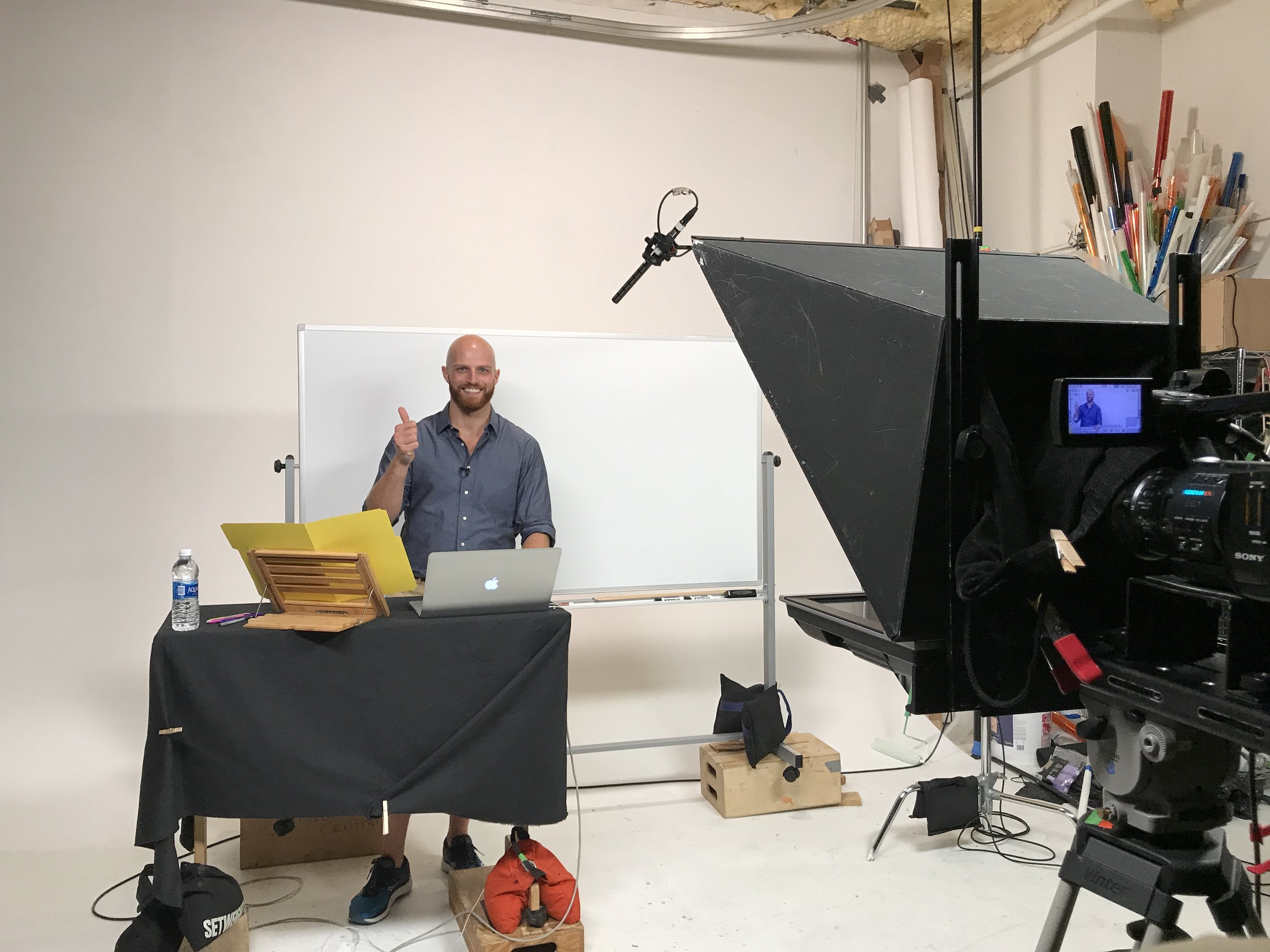In February, I gave the above talk -- one of my favourites, on the Fundamentals of Deep Learning -- to the NYC Open Data Meetup. Tonight, following months of curriculum development, I'm providing an overview of the part-time Deep Learning course that I'm offering at the Meetup's affiliate, the NYC Data Science Academy, from October through December. The event is sold out, but a live stream will be available from 7pm Eastern Time (link through here).
“Deep Learning with TensorFlow” Introductory Tutorials with Jupyter Notebooks →
My hands-on introduction to Deep Learning is now available in Safari. The accompanying Jupyter notebooks are available for free in GitHub. Below is a free excerpt from the full series of lessons:
How to Understand How LSTMs Work →
In the twelfth iteration of our Deep Learning Study Group, we talked about a number of Deep Learning techniques pertaining to Natural Language Processing, including Attention, Convolutional Neural Networks, Tree Recursive Neural Networks, and Gated Recurrent Units. Our collective effort was primarily focused on a popular variant of the latter -- Long Short-Term Memory units. This blog post provides a high-level overview of what LSTMs are, why they're suddenly ubiquitous, and the resources we recommend working through to understand them.
Filming "Deep Learning with TensorFlow LiveLessons" for Safari Books →
We recently wrapped up filming my five-hour Deep Learning with TensorFlow LiveLessons. These hands-on, introductory tutorials are published by Pearson and will become available in the Safari Books online environment in August.
HackFemme 2017 →
On Friday, I had the humbling experience of contributing to a panel on becoming a champion of diversity at the Coalition for Queens' inaugural (and immaculately-run) HackFemme conference for women in software engineering. The consensus among the panelists (Sarah Manning, Etsy; Patricia Goodwin-Peters, Kate Spade) during the articulately-moderated hour (thanks to Valerie Biberaj) was that much can be accomplished by focusing on the present moment and, for example, speaking up for the softer-voiced contributors to a business discussion.
Deep Learning Study Group XI: Recurrent Neural Networks, including GRUs and LSTMs →
Last week, we welcomed Claudia Perlich and Brian Dalessandro as outstanding speakers at our study session, which focused on deep neural net approaches for handling natural language tasks like sentiment analysis or translation between languages.
Deep Learning Study Group 10: word2vec Mania + Generative Adversarial Networks →
In our tenth session, we delved into the theory and practice of converting human language into fodder for machines. Specifically, we discussed the mathematics and software application of word2vec, a popular approach for converting natural language into a high-dimensional vector space.
Deep Learning Study Group IX: Natural Language Processing, AI in Fashion, and U-Net
In our most recent session, we began learning about word vectors and vector-space embeddings. This is a stepping stone en route to applying Deep Learning techniques to process natural language.
Deep Learning Study Group VIII: Unsupervised Learning, Regularisation, and Venture Capital →
At the eighth iteration of our Deep Learning Study Group, we discussed unsupervised learning techniques and enjoyed presentations from Raffi Sapire and Katya Vasilaky on venture capital investment for machine-learning start-ups and L2 regularisation, respectively.
Fundamental Deep Learning code in TFLearn, Keras, Theano and TensorFlow →
I had a ball giving this talk on Deep Learning hosted by the Open Statistical Programming Meetup at eBay New York last week. It was a packed house, with many thoughtful questions and fruitful discussions. This post summarises the content, and includes the full video, the slides, Jupyter notebooks, and an introduction to the code snippets I presented.
Introductory Talk on Deep Learning at Wilfrid Laurier University →
I gave an introductory talk on the Artificial Intelligence approach Deep Learning last week to the Faculty of Science at Wilfrid Laurier University on what it is, how it's impacting each of us today, and how it is poised to become ever-more uniquitous in the years to come. Here is a summary write-up.
Upcoming Talk: Deep Learning with Artificial Neural Networks →
Next week, I'll be giving an introductory, public lecture on the topics I'm most passionate about -- Deep Learning and AI -- at Wilfrid Laurier University. If you're in Waterloo, Ontario, I'd love to share it with you live -- on January 4th at 4pm. Click through the title for details.
Deep Learning Study Group #6: A History of Machine Vision →
A fortnight ago, our Deep Learning Study Group held a particularly fun and engaging session.
This was our first meeting since completing Michael Nielsen’s Neural Networks and Deep Learning text. Nielsen’s work provided us with a solid foundation for exploring more thoroughly the convolutional neural nets that are the de facto standard in contemporary machine-vision applications.
Deep Learning Study Group #5: How Deep Convolutional Neural Networks Work and How to Improve Them →
This week, our Deep Learning Study Group focused on a popular neural network architecture for machine vision called Convolutional Neural Networks. This technique is used to, for example, recognise that a face is yours on Facebook or to enable Tesla's self-driving cars to identify traffic. Modelled loosely on the primate visual cortex, this approach is powerful and has become ubiquitous within contemporary Artificial Intelligence.
“Fundamentals of Deep Learning” talk to Data Science + FinTech Meetup →
On Wednesday, I had the joy of presenting to a highly-engaged audience at the Data Science + FinTech meetup. Click through for a quick summary, my full slides, and video clips.
Deep Learning Study Group Session #4: Proofs of Key Neural Net Properties →
In our fourth iteration, we discussed key neural net properties, namely that they can compute any function and that deep ones tend to have unstable (typically, vanishing) gradients.
Three Themes of Seth Moulton’s Inaugural Term, Visualized with Data →
In 2014, I volunteered on Congressman Seth Moulton's first political campaign. Two years on, I've dusted off my media-analytics toolkit to summarize his inaugural term in office with data visualizations.
It's a joy to see Seth working with Democrats and Republicans alike to deliver for his country and his constituents in Massachusetts. Running unopposed this November, I'm excited to see the contributions his across-the-aisle diplomacy will bring in his second term.
Deep Learning Study Group Session #3: Improving Neural Networks →
During the third installment of our Deep Learning Study Group, we examined rules of thumb for improving neural networks. This post summarises what we covered, including step-by-step details for tuning a network's hyperparameters.
Deep Learning Study Group Session #2: The Backpropagation Algorithm →
Our Deep Learning Study Group moved forward yesterday by focusing on the ubiquitous Backpropagation Algorithm.
Minimizing Unwanted Bias with Recruitment Algorithms →
I woke up this morning to a thoughtful Financial Times piece on the “risks of relying on robots for fairer staff recruitment”.
While the author advances well-founded concerns for our industry, the risks associated with integrating algorithms into the talent acquisition process are appreciably offset by the benefits: scalability, access to a broader candidate pool, and, vitally, openness.


















